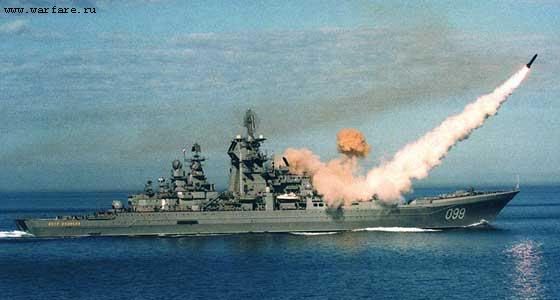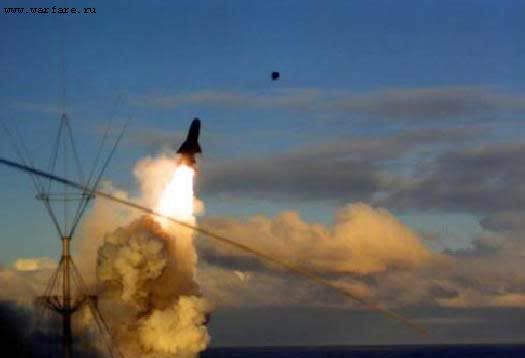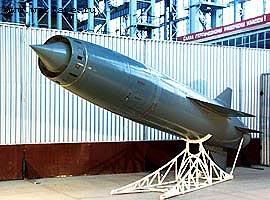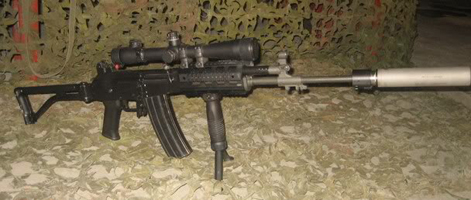Apenas lembrando aos colegas, que a ogiva do Granit de 750kg de HE é mais pesado do que o Exocet AM 39 que pesa cerca de 650kg no momento do lançamento...Luís Henrique escreveu:So se for a fumaça de um Granit sendo lançado.Carlos Mathias escreveu:E a fumaça? Já consegues avistar no horizonte?

Nossa, eu sou fã desse míssil.
Um Tomahawk pesa 1.500 kg, um Brahmos pesa 3.000 kg e um Granit consegue pesar 7.000 kg.
Mais de 600 km de alcance a mais de 3 Mach, lambendo a água do mar e com uma ogiva convencional de 750 kg HE ou uma NUCLEAR é DEMAIS pras marinhas que operam misseis da classe do Harpoon.....
Marinha da Federação Russa
Moderador: Conselho de Moderação
-
WalterGaudério
- Sênior

- Mensagens: 13539
- Registrado em: Sáb Jun 18, 2005 10:26 pm
- Agradeceu: 56 vezes
- Agradeceram: 201 vezes
Re: Marinha da Federação Russa
Só há 2 tipos de navios: os submarinos e os alvos...
Armam-se homens com as melhores armas.
Armam-se Submarinos com os melhores homens.
Os sábios PENSAM
Os Inteligentes COPIAM
Os Idiotas PLANTAM e os
Os Imbecis FINANCIAM...
Armam-se homens com as melhores armas.
Armam-se Submarinos com os melhores homens.
Os sábios PENSAM
Os Inteligentes COPIAM
Os Idiotas PLANTAM e os
Os Imbecis FINANCIAM...
- cabeça de martelo
- Sênior

- Mensagens: 41791
- Registrado em: Sex Out 21, 2005 10:45 am
- Localização: Portugal
- Agradeceu: 1265 vezes
- Agradeceram: 3276 vezes
Re: Marinha da Federação Russa
Carlos Mathias escreveu:E a fumaça? Já consegues avistar no horizonte?
-
Quiron
- Sênior

- Mensagens: 1375
- Registrado em: Sáb Abr 01, 2006 9:41 pm
- Localização: Brasília-DF.
- Agradeceu: 28 vezes
- Agradeceram: 76 vezes
Re: Marinha da Federação Russa
Características:
Type: supersonic speed cruise missile
Year: 1983
Range (km): 650
Weight (kg): 7000
Lenght (m): 19.50 x 0.88
Wingspan (m): 2.60
Guidance: inertial with command update, active radar/IR and anti-radar homing
Speed: 2.5 Mach
Propulsion: 2 solid-fuel boosters
1 turbojet sustainer engine
Warhead: 750 kg conventional high explosive or
500 kiloton nuclear warhead
==
Russian Designation
P-700 Granit (3M45)
NATO / DoD Designation
SS-N-19 Shipwreck
Manufacturer
NPO Mashinostroenia Chelomey
Guidance
Mid-course autopilot; terminal active / passive radar seeker
Warhead
750 kg HE or 200/350 kT nuclear or submunitions
Propulsion
one solid-fuel boosters, turbojet sustainer
Range
550 km
Speed
Mach 2.5 / 835 m/sec
Length
10.00 m
Body Diameter
853 mm
Wingspan
2,600 mm
Launch Weight
7,000 kg
Development Start
1969
Date Operational
1983



História:
The improved US ASW defenses around carrier battlegroups during the 1970s increasingly restricted the effectiveness of Soviet submarines carrying the SS-N-7/9 ‘Starbright/’ Siren’ (Ametist/Malachit). At the same time the Soviet Navy wished to strengthen the defenses of its SSBN bastions and this led to a requirement for a new missile. The P-700 Granat [SSN-19 Shipwreck] was developed as a more successful turbojet alternative to the SSN-12 Sandbox, from which it was derived.
The missile is believed to have an inertial guidance system possibly with provision for mid-course guidance in over-the-horizon (OTH) engagements although this seems unlikely. Following the usual Soviet practice the missile employs active radar terminal guidance. It uses a 750 kg high explosive warhead with impact and proximity fuses. Alternative payloads were reported to be nuclear or fuel-air explosive. However, it seems more probable that the aircraft and the satellite feed target location data to the ships, and it is noteworthy that all the ‘Shipwreck’ launch platforms carry ‘Punch Bowl’ satellite communications systems.
The development of the P-700 missile system started in 1969, but it was prolonged due to its complexity. It was assumed that the main source of information would be the satellite-based reconnaissance network, and from the very beginning, it was believed that the missile would be able to communicate with it directly after launch. The initial targeting information was to be received by a submarine cruising at a depth of about 30 m via a long-wave communications system from ground bases. The attack was to be coordinated with a group of long-range Tu-22M anti-ship aircraft. The underwater attack group consists of three to five Oscar and Oscar II subs, each armed with 24 P-700 missiles. The subs were to launch 70-120 such missiles against a single carrier group in a single mass attack. Roughly 30-50% of them are aimed at the carrier, while the others go after accompanying ships. Another salvo of 12-24 missiles was to be launched by aircraft,
mainly to saturate the carrier group's defenses. The 30-knot speed of the Oscar I/II submarines enables a rapid approach to the launch area, about 450-500 km from the carrier group, and equally quick evasion after the attack.
The missile employs all of the techniques from the Bazalt / Vulkan. One lead missile per every 24 in the salvo flies at high altitude to reconnoiter the target, using its radar in active and passive modes. The active mode is used in quick "looks," then turned off to increase the penetration probability. The lead missile assigns targets to all subordinate missiles and communicates with the other lead missiles in the massive salvo to coordinate the attack. To achieve this, the missile is equipped with a powerful digital computer with three processors. The missile has an onboard integrated electronic-countermeasures suit for avoiding enemy anti-missile attacks using a combination of maneuver and deception jamming. The computer could order the missile to one of various stored courses with multiple altitudes. At high altitude, the missile speed is Mach 2.5, while at low (sea-skimming) altitude, it is Mach 1.5. Vital parts of the missile are armored to increase penetration against fire from Phalanx-type close-in weapon systems and against fragments of closely exploding air-defense missiles. The missile has a nuclear warhead with a selectable yield of 200 or 350 kT, or a conventional 750 kg unitary shaped charge, or bomblets (primary for anti-ship attack, but also useable against land targets: 750 x 1 kg, a mix of incendiary, AP, HE, which can be varied to meet requirements).
The missile has a KR-93 turbojet which is used in the cruising phase after the missile has been launched with the aid of an intregal solid propellant booster in the tail. There are two sharply swept-back wings and two swept-back tail fins with a stabiliser on the top side of the missile. The seeker is reported to operate in ESM, J-band (10-12 GHz) and K-band (27-40 GHz) modes, using the last in the terminal phase to select specific targets.
The guidance system was developed by TsNII "Granit." The missile itself was developed in OKB-52 (later NPO Mashinostoyeniya) under the direction of Chelomey and, after his death in 1984, under Gerberd Efremov. First tests of the missile started in November 1975. Numerous difficulties prolonged the factory tests until 1979, and in autumn of that year, the missile began state trials. Technical difficulties further prolonged the trials through October 1983, and the missile was officially accepted into service in March 1983. At this time, the space-based Legenda reconnaissance system had been fully deployed. In addition to the satellite system, the submarine could also use its own MGK-540 Skat-3 sonar system for targeting.
The Shipwreck's initial employment was on the battle cruiser Kirov (later renamed Admiral Ushakov). The Shipwreck was subsequently deployed on the nuclear powered cruiser Peter the Great. It is also deployed on submarines, which can launch the missile while submerged. Some 300 missiles are believed to have been produced but production is complete. The missile is used only by the Russian Navy.
Type: supersonic speed cruise missile
Year: 1983
Range (km): 650
Weight (kg): 7000
Lenght (m): 19.50 x 0.88
Wingspan (m): 2.60
Guidance: inertial with command update, active radar/IR and anti-radar homing
Speed: 2.5 Mach
Propulsion: 2 solid-fuel boosters
1 turbojet sustainer engine
Warhead: 750 kg conventional high explosive or
500 kiloton nuclear warhead
==
Russian Designation
P-700 Granit (3M45)
NATO / DoD Designation
SS-N-19 Shipwreck
Manufacturer
NPO Mashinostroenia Chelomey
Guidance
Mid-course autopilot; terminal active / passive radar seeker
Warhead
750 kg HE or 200/350 kT nuclear or submunitions
Propulsion
one solid-fuel boosters, turbojet sustainer
Range
550 km
Speed
Mach 2.5 / 835 m/sec
Length
10.00 m
Body Diameter
853 mm
Wingspan
2,600 mm
Launch Weight
7,000 kg
Development Start
1969
Date Operational
1983



História:
The improved US ASW defenses around carrier battlegroups during the 1970s increasingly restricted the effectiveness of Soviet submarines carrying the SS-N-7/9 ‘Starbright/’ Siren’ (Ametist/Malachit). At the same time the Soviet Navy wished to strengthen the defenses of its SSBN bastions and this led to a requirement for a new missile. The P-700 Granat [SSN-19 Shipwreck] was developed as a more successful turbojet alternative to the SSN-12 Sandbox, from which it was derived.
The missile is believed to have an inertial guidance system possibly with provision for mid-course guidance in over-the-horizon (OTH) engagements although this seems unlikely. Following the usual Soviet practice the missile employs active radar terminal guidance. It uses a 750 kg high explosive warhead with impact and proximity fuses. Alternative payloads were reported to be nuclear or fuel-air explosive. However, it seems more probable that the aircraft and the satellite feed target location data to the ships, and it is noteworthy that all the ‘Shipwreck’ launch platforms carry ‘Punch Bowl’ satellite communications systems.
The development of the P-700 missile system started in 1969, but it was prolonged due to its complexity. It was assumed that the main source of information would be the satellite-based reconnaissance network, and from the very beginning, it was believed that the missile would be able to communicate with it directly after launch. The initial targeting information was to be received by a submarine cruising at a depth of about 30 m via a long-wave communications system from ground bases. The attack was to be coordinated with a group of long-range Tu-22M anti-ship aircraft. The underwater attack group consists of three to five Oscar and Oscar II subs, each armed with 24 P-700 missiles. The subs were to launch 70-120 such missiles against a single carrier group in a single mass attack. Roughly 30-50% of them are aimed at the carrier, while the others go after accompanying ships. Another salvo of 12-24 missiles was to be launched by aircraft,
mainly to saturate the carrier group's defenses. The 30-knot speed of the Oscar I/II submarines enables a rapid approach to the launch area, about 450-500 km from the carrier group, and equally quick evasion after the attack.
The missile employs all of the techniques from the Bazalt / Vulkan. One lead missile per every 24 in the salvo flies at high altitude to reconnoiter the target, using its radar in active and passive modes. The active mode is used in quick "looks," then turned off to increase the penetration probability. The lead missile assigns targets to all subordinate missiles and communicates with the other lead missiles in the massive salvo to coordinate the attack. To achieve this, the missile is equipped with a powerful digital computer with three processors. The missile has an onboard integrated electronic-countermeasures suit for avoiding enemy anti-missile attacks using a combination of maneuver and deception jamming. The computer could order the missile to one of various stored courses with multiple altitudes. At high altitude, the missile speed is Mach 2.5, while at low (sea-skimming) altitude, it is Mach 1.5. Vital parts of the missile are armored to increase penetration against fire from Phalanx-type close-in weapon systems and against fragments of closely exploding air-defense missiles. The missile has a nuclear warhead with a selectable yield of 200 or 350 kT, or a conventional 750 kg unitary shaped charge, or bomblets (primary for anti-ship attack, but also useable against land targets: 750 x 1 kg, a mix of incendiary, AP, HE, which can be varied to meet requirements).
The missile has a KR-93 turbojet which is used in the cruising phase after the missile has been launched with the aid of an intregal solid propellant booster in the tail. There are two sharply swept-back wings and two swept-back tail fins with a stabiliser on the top side of the missile. The seeker is reported to operate in ESM, J-band (10-12 GHz) and K-band (27-40 GHz) modes, using the last in the terminal phase to select specific targets.
The guidance system was developed by TsNII "Granit." The missile itself was developed in OKB-52 (later NPO Mashinostoyeniya) under the direction of Chelomey and, after his death in 1984, under Gerberd Efremov. First tests of the missile started in November 1975. Numerous difficulties prolonged the factory tests until 1979, and in autumn of that year, the missile began state trials. Technical difficulties further prolonged the trials through October 1983, and the missile was officially accepted into service in March 1983. At this time, the space-based Legenda reconnaissance system had been fully deployed. In addition to the satellite system, the submarine could also use its own MGK-540 Skat-3 sonar system for targeting.
The Shipwreck's initial employment was on the battle cruiser Kirov (later renamed Admiral Ushakov). The Shipwreck was subsequently deployed on the nuclear powered cruiser Peter the Great. It is also deployed on submarines, which can launch the missile while submerged. Some 300 missiles are believed to have been produced but production is complete. The missile is used only by the Russian Navy.
-
Carlos Mathias
Re: Marinha da Federação Russa
Porra, 120 mísseis chegando a mach 2 e fazendo manobras feito louco... Será que tem como evitar que uns dois acertem o alvo principal?
-
felipexion
- Sênior

- Mensagens: 3548
- Registrado em: Sex Ago 17, 2007 11:06 am
- Localização: Bahia!
- Agradeceu: 74 vezes
- Agradeceram: 87 vezes
Re: Marinha da Federação Russa
Como sempre o problema é dinheiro. Se for depender das verbas atuais, vai ficar apenas no sonho.P44 escreveu:
bota a grana no Kremlin que eles constroem
[centralizar]Mazel Tov![/centralizar]
- Edu Lopes
- Sênior

- Mensagens: 4549
- Registrado em: Qui Abr 26, 2007 2:18 pm
- Localização: Brasil / Rio de Janeiro / RJ
Re: Marinha da Federação Russa
Submarino nuclear russo lança míssil balístico em direção a alvo no Pacífico
Rússia - A Rússia realizou hoje com sucesso o lançamento de teste de um míssil balístico intercontinental da posição de imersão para um alvo situado no Oceano Pacífico.
O submarino nuclear "Tula" fez o lançamento durante manobras navais da Frota do Norte russa, presenciadas pelo presidente da Rússia, Dmitri Medvedev, a partir do porta-aviões "Admiral Kuznetsov", informaram as agências.
O lançamento do míssil Sineva em direção ao alvo tinha como finalidade testar e confirmar as características do mesmo, disse o porta-voz da Marinha russa, capitão de navio Igor Digalo.
"Pela primeira vez na história da Marinha russa, o lançamento não tinha como alvo o polígono de Kura, na península de Kamchatka, mas a parte equatorial do Pacífico", afirmou.
Digalo disse que "é uma prova da disposição das forças navais nucleares para o lançamento de um míssil intercontinental balístico dentro dos exercícios estratégicos Stabilnost 2008".
Os Sineva, projetados pela empresa de mísseis Makeyev, com sede em Miass, na região de Chelyabinsk, completaram o período oficial de testes em 2004, e em 9 de julho de 2007 entraram em serviço na Marinha russa.
Os RSM-54 Sineva (Skiff SS-N-23) são mísseis intercontinentais de terceira geração com alcance de 8,9 mil quilômetros e têm quatro ogivas guiadas individualmente.
Esses mísseis funcionam com combustível líquido, pesam 40,3 toneladas e têm 14,8 metros de comprimento.
As informações são da EFE
Fonte: http://odia.terra.com.br/mundo/htm/subm ... 205576.asp
Rússia - A Rússia realizou hoje com sucesso o lançamento de teste de um míssil balístico intercontinental da posição de imersão para um alvo situado no Oceano Pacífico.
O submarino nuclear "Tula" fez o lançamento durante manobras navais da Frota do Norte russa, presenciadas pelo presidente da Rússia, Dmitri Medvedev, a partir do porta-aviões "Admiral Kuznetsov", informaram as agências.
O lançamento do míssil Sineva em direção ao alvo tinha como finalidade testar e confirmar as características do mesmo, disse o porta-voz da Marinha russa, capitão de navio Igor Digalo.
"Pela primeira vez na história da Marinha russa, o lançamento não tinha como alvo o polígono de Kura, na península de Kamchatka, mas a parte equatorial do Pacífico", afirmou.
Digalo disse que "é uma prova da disposição das forças navais nucleares para o lançamento de um míssil intercontinental balístico dentro dos exercícios estratégicos Stabilnost 2008".
Os Sineva, projetados pela empresa de mísseis Makeyev, com sede em Miass, na região de Chelyabinsk, completaram o período oficial de testes em 2004, e em 9 de julho de 2007 entraram em serviço na Marinha russa.
Os RSM-54 Sineva (Skiff SS-N-23) são mísseis intercontinentais de terceira geração com alcance de 8,9 mil quilômetros e têm quatro ogivas guiadas individualmente.
Esses mísseis funcionam com combustível líquido, pesam 40,3 toneladas e têm 14,8 metros de comprimento.
As informações são da EFE
Fonte: http://odia.terra.com.br/mundo/htm/subm ... 205576.asp


- Rui Elias Maltez
- Sênior

- Mensagens: 13951
- Registrado em: Ter Nov 16, 2004 1:38 pm
- Localização: Sintra, Portugal
- Agradeceram: 1 vez
- Contato:
Re: Marinha da Federação Russa
Vai brincando, a Rússia!"Pela primeira vez na história da Marinha russa, o lançamento não tinha como alvo o polígono de Kura, na península de Kamchatka, mas a parte equatorial do Pacífico", afirmou.

- P44
- Sênior

- Mensagens: 56138
- Registrado em: Ter Dez 07, 2004 6:34 am
- Localização: O raio que vos parta
- Agradeceu: 3015 vezes
- Agradeceram: 2710 vezes
Re: Marinha da Federação Russa
Lançamento do missil balistico, visto de bordo do "Admiral Flota Soviestko Soyuza Kuznetsov" 

outras fotos a bordo:




outras fotos a bordo:



*Turn on the news and eat their lies*
-
brisa
Re: Marinha da Federação Russa
Nuclear-powered cruiser ready for new fuel
03.10.2008

The Sevmash yard in Severodvinsk, Arkhangelsk Oblast, has started the discharging of spent nuclear fuel from the cruiser Admiral Nakhimov. The vessel has been moored by the yard since 1999 awaiting the operation.
According to the Sevmash press service, the operation is conducted by local specialists together with representatives of the Nizhny Novgorod-based company OKBM Afrikantov and the crew of a support vessel from the Belomorye navy base.
Lack of funding has forced the Navy to let heavy cruiser lie moored in Severodvinsk for the last nine years. The 24,500 ton vessel still remains in good shape thanks to regular maintenance from Sevmash.
The Admiral Nakhimov is 251 meter long. It has two reactors. The main military hardware is Granit cruiser missile, the Fort anti-aircraft missile, as well as the Osa-MA and Vodopad missiles. The ship also has three Ka-27 helicopters, Sevmash informs.
03.10.2008

The Sevmash yard in Severodvinsk, Arkhangelsk Oblast, has started the discharging of spent nuclear fuel from the cruiser Admiral Nakhimov. The vessel has been moored by the yard since 1999 awaiting the operation.
According to the Sevmash press service, the operation is conducted by local specialists together with representatives of the Nizhny Novgorod-based company OKBM Afrikantov and the crew of a support vessel from the Belomorye navy base.
Lack of funding has forced the Navy to let heavy cruiser lie moored in Severodvinsk for the last nine years. The 24,500 ton vessel still remains in good shape thanks to regular maintenance from Sevmash.
The Admiral Nakhimov is 251 meter long. It has two reactors. The main military hardware is Granit cruiser missile, the Fort anti-aircraft missile, as well as the Osa-MA and Vodopad missiles. The ship also has three Ka-27 helicopters, Sevmash informs.
-
dron_pizdec
- Intermediário

- Mensagens: 194
- Registrado em: Sex Mai 18, 2007 9:19 am
- Contato:
Re: Marinha da Federação Russa
Finalmente, o Nakhimov esta pronto... ![Forca [002]](./images/smilies/002.gif)
![[006]](./images/smilies/006.gif)
Ainda precisamos o fim do "manutencao geral" do Lazarev no Pacifico...
Ainda precisamos o fim do "manutencao geral" do Lazarev no Pacifico...
-
JLRC
- Sênior

- Mensagens: 2513
- Registrado em: Qui Dez 09, 2004 11:33 am
- Localização: Almada-Portugal
- Agradeceram: 1 vez
Re: Marinha da Federação Russa
O Lazarev vai mesmo ser reactivado? Tenho as minhas dúvidasdron_pizdec escreveu:Finalmente, o Nakhimov esta pronto...![Forca [002]](./images/smilies/002.gif)
![[006]](./images/smilies/006.gif)
Ainda precisamos o fim do "manutencao geral" do Lazarev no Pacifico...
-
brisa
Re: Marinha da Federação Russa
Talvez em no minimo, mais 12/15 anosJLRC escreveu:O Lazarev vai mesmo ser reactivado? Tenho as minhas dúvidasdron_pizdec escreveu:Finalmente, o Nakhimov esta pronto...![Forca [002]](./images/smilies/002.gif)
![[006]](./images/smilies/006.gif)
Ainda precisamos o fim do "manutencao geral" do Lazarev no Pacifico...
- P44
- Sênior

- Mensagens: 56138
- Registrado em: Ter Dez 07, 2004 6:34 am
- Localização: O raio que vos parta
- Agradeceu: 3015 vezes
- Agradeceram: 2710 vezes
Re: Marinha da Federação Russa
só o Nakhimov vai ser reactivado
..........
http://www.itar-tass.com/eng/level2.htm ... &PageNum=0
..........
RUSSIA
Chinese naval squadron calls at Vladivostok Tuesday
14.10.2008, 05.26
VLADIVOSTOK, October 14 (Itar-Tass) - A squadron of combatant ships of the naval forces of the People's Liberation Army (PLA) of China, called here on Tuesday for a visit. The squadron consists of the destroyer "Tai Zhou" and the guided missile frigate "Ma Anshan".
An officer in the information and public relations service of Russia's Pacific Feet (PF) has told Itar-Tass that the naval squadron's four-day visit is made under the flag of Vice-Admiral Xu Hungmeng, Commander of the PLA's East Sea (Sea of Japan) Fleet, who arrived in the main city of the Primorsky Territory for this purpose earlier in the day.
"The present meeting between Russian and Chinese navy men pursues the main aim: to promote a further development of naval cooperation between the navies of our two countries," the PF information service officer pointed out.
The programme for the visit is traditional: the PF Command and the PT administration chief will receive Chinese seamen. The programme also envisages bus tours, basketball competitions, and a number of official functions and informal get-togethers of the seamen of the two countries. Hosts on the Russian side are the large anti-submarine ships Admiral Panteleyev and Admiral Tributs.
This is a fifth call at Vladivostok by a Chinese naval squadron. Last time naval ships of the PLA and PF Marines participated in large-scale bilateral anti-terrorist exercises "Peace Mission-2005" that took place in the area of the Liaodong Peninsula.
http://www.itar-tass.com/eng/level2.htm ... &PageNum=0
*Turn on the news and eat their lies*
- Naval
- Sênior

- Mensagens: 1506
- Registrado em: Dom Jul 27, 2003 10:06 am
- Agradeceu: 156 vezes
- Agradeceram: 43 vezes
Re: Marinha da Federação Russa
O Nakhimov é outro cruzador da Classe Kirov??dron_pizdec escreveu:Finalmente, o Nakhimov esta pronto...![Forca [002]](./images/smilies/002.gif)
![[006]](./images/smilies/006.gif)
Ainda precisamos o fim do "manutencao geral" do Lazarev no Pacifico...
Abraços.
Editado pela última vez por Naval em Sáb Out 18, 2008 9:01 pm, em um total de 1 vez.
"A aplicação das leis é mais importante que a sua elaboração." (Thomas Jefferson)
- Rui Elias Maltez
- Sênior

- Mensagens: 13951
- Registrado em: Ter Nov 16, 2004 1:38 pm
- Localização: Sintra, Portugal
- Agradeceram: 1 vez
- Contato:



